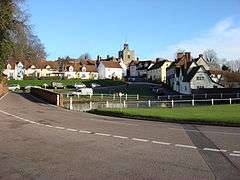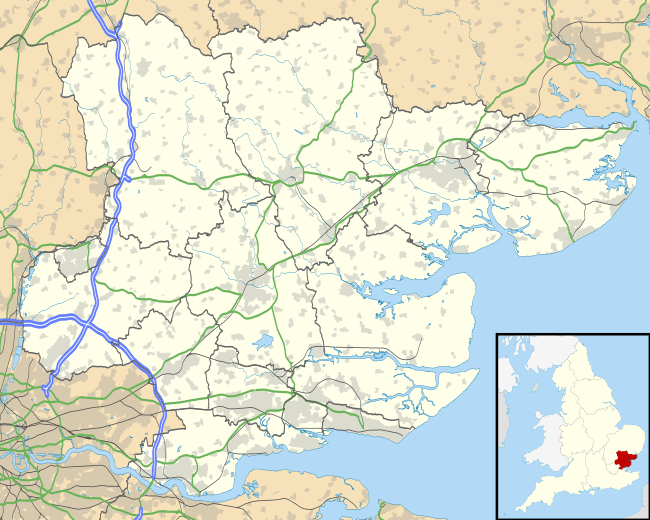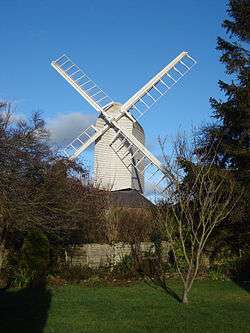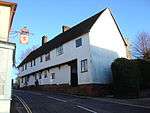Finchingfield
| Finchingfield | |
 Finchingfield looking east |
|
 Finchingfield |
|
| Population | 1,471 (2011)[1] |
|---|---|
| OS grid reference | TL683327 |
| – London | 40 mi (64 km) SW |
| Civil parish | Finchingfield |
| District | Braintree |
| Shire county | Essex |
| Region | East |
| Country | England |
| Sovereign state | United Kingdom |
| Post town | Braintree |
| Postcode district | CM7 |
| Dialling code | 01371 |
| Police | Essex |
| Fire | Essex |
| Ambulance | East of England |
| EU Parliament | East of England |
Coordinates: 51°58′03″N 0°27′00″E / 51.96747°N 0.44995°E
Finchingfield is a village in the Braintree district in north-west Essex, England, a primarily rural area. It is approximately 6 miles (10 km) from Thaxted, further from the larger towns of Saffron Walden and Braintree.
Nearby villages include Great Bardfield, Great Sampford, and Wethersfield.
History
There has been a settlement in Finchingfield since historical records of the area began. There also is archaeological evidence for a Roman villa 400 metres south-south-west of the village church. Finchingfield was recorded in the Domesday Book as Phincingfelda.[2] The village was an official stop for horse-drawn coaches travelling from London to Norwich.
Spains Hall, the nearby Elizabethan country house, was built in the early fifteenth century. The hall is named after Hervey de Ispania, who held the manor at the time of the 1086 Domesday Book. Since then, the land has been owned by three families: the de Ispania family, the Kempe family, who acquired it when Margery de Ispania married Nicholas Kempe in the early fifteenth century, and the Ruggles family (later the Ruggles-Brise family who reside there today). The hall was the hub of the community, those families owning much of the village, and employing most of the villagers.[3]
Community
Finchingfield and Cornish Hall End combined had a population of 1,471 at the United Kingdom Census 2011.[4]
The ecclesiastical parish covering Finchingfield includes Cornish Hall End, Shalford, and Wethersfield.
Societies and clubs founded in Finchingfield, include The Finchingfield Society, the Horticultural Society, the Royal British Legion, and Finchingfield Cricket Club.[3]
It often is called the most beautiful village in England, a "picture-postcard" village and one of the most photographed, with a duck pond and village green surrounded by Georgian and medieval cottages; St John the Baptist Church on the hill; an eighteenth-century windmill; three public houses; Post Office; tea rooms; a hall; a primary school; and a doctor's surgery.[3] It often has appeared in television programmes, films, and commercials, as well as on chocolate boxes, biscuit tins, and other products.
Finchingfield was the home and is the burial place of Dodie Smith, whose books include The Hundred and One Dalmatians (1956). She lived in The Barretts at Howe Street, a hamlet in the parish about 1.5 miles (2.4 km) from the village.[5]
The 2013 Sky series Chickens was filmed in the village. The series concerns three young men who avoided going to fight during the Second World War, written by and starring Simon Bird and Joe Thomas.
Notable people
- Thomas Howard, 21st Earl of Arundel
- Norman Lewis, travel writer, novelist, founder of Survival International
- Dodie Smith, author of The Hundred and One Dalmatians[5]
Gallery
Jun2005.jpg) Finchingfield, June 2005
Finchingfield, June 2005
 Finchingfield Guildhall (before 2011-2013 restoration)[6]
Finchingfield Guildhall (before 2011-2013 restoration)[6] The church of St. John the Baptist
The church of St. John the Baptist The Fox Inn, Finchingfield
The Fox Inn, Finchingfield
References
- ↑ "Civil Parish population 2011". Neighbourhood Statistics. Civil Parish population 2011. Retrieved 2 September 2016.
- ↑ http://www.essexlifemag.co.uk/out-about/places/once_upon_a_time_in_finchingfield_1_1634282
- 1 2 3 Jarvis, Joanne (November 2008). "Finchingfield's friendly faces". Essex Life. Archant. pp. 78–79. Retrieved 24 January 2009. (Registration required)
- ↑ "Finchingfield & Cornish Hall End", Braintree District Council. Retrieved 4 January 2015
- 1 2 "Cruella's 'home' up for sale". BBC News. BBC. 25 September 2002. Retrieved 24 January 2009.
- ↑ "Guildhall Finchingfield Essex", Retrieved 4 January 2015
See also
External links
 Media related to Finchingfield at Wikimedia Commons
Media related to Finchingfield at Wikimedia Commons- Images of Finchingfield
- Cliff Lawson's tribute to Finchingfield